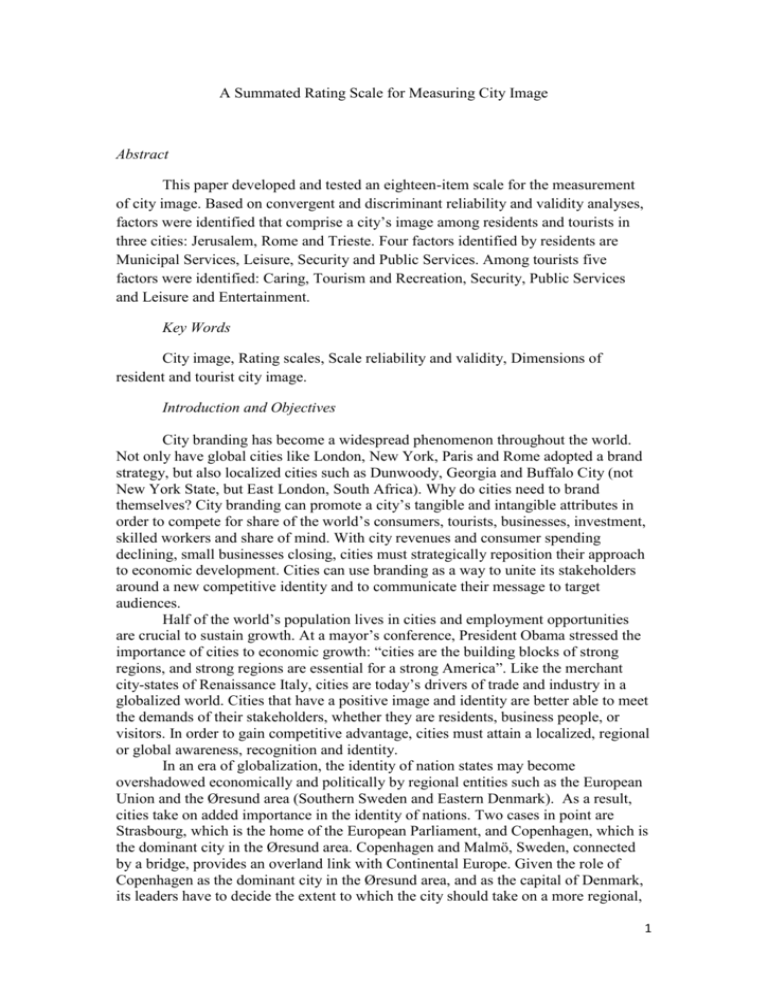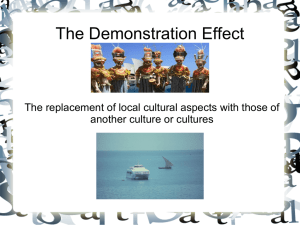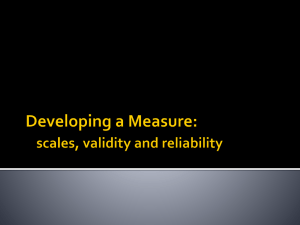- International Marketing Trends Conference
advertisement

A Summated Rating Scale for Measuring City Image Abstract This paper developed and tested an eighteen-item scale for the measurement of city image. Based on convergent and discriminant reliability and validity analyses, factors were identified that comprise a city’s image among residents and tourists in three cities: Jerusalem, Rome and Trieste. Four factors identified by residents are Municipal Services, Leisure, Security and Public Services. Among tourists five factors were identified: Caring, Tourism and Recreation, Security, Public Services and Leisure and Entertainment. Key Words City image, Rating scales, Scale reliability and validity, Dimensions of resident and tourist city image. Introduction and Objectives City branding has become a widespread phenomenon throughout the world. Not only have global cities like London, New York, Paris and Rome adopted a brand strategy, but also localized cities such as Dunwoody, Georgia and Buffalo City (not New York State, but East London, South Africa). Why do cities need to brand themselves? City branding can promote a city’s tangible and intangible attributes in order to compete for share of the world’s consumers, tourists, businesses, investment, skilled workers and share of mind. With city revenues and consumer spending declining, small businesses closing, cities must strategically reposition their approach to economic development. Cities can use branding as a way to unite its stakeholders around a new competitive identity and to communicate their message to target audiences. Half of the world’s population lives in cities and employment opportunities are crucial to sustain growth. At a mayor’s conference, President Obama stressed the importance of cities to economic growth: “cities are the building blocks of strong regions, and strong regions are essential for a strong America”. Like the merchant city-states of Renaissance Italy, cities are today’s drivers of trade and industry in a globalized world. Cities that have a positive image and identity are better able to meet the demands of their stakeholders, whether they are residents, business people, or visitors. In order to gain competitive advantage, cities must attain a localized, regional or global awareness, recognition and identity. In an era of globalization, the identity of nation states may become overshadowed economically and politically by regional entities such as the European Union and the Øresund area (Southern Sweden and Eastern Denmark). As a result, cities take on added importance in the identity of nations. Two cases in point are Strasbourg, which is the home of the European Parliament, and Copenhagen, which is the dominant city in the Øresund area. Copenhagen and Malmö, Sweden, connected by a bridge, provides an overland link with Continental Europe. Given the role of Copenhagen as the dominant city in the Øresund area, and as the capital of Denmark, its leaders have to decide the extent to which the city should take on a more regional, 1 as opposed to its current local identity. This identity is crucial for attracting a city’s target markets, such as tourists, investors and skilled workers. Cities compete with one another for awareness, recognition and ultimately, money. Some cities are identified as hosts for mega-events, such as Beijing, Seoul, Athens and St. Moritz. Others cities are identified with international festivals, e.g. wine (Budapest, Mosel, Porto), films (Cannes, Las Vegas), music (Atlantic City, Prague), fashion (New York, Rome, Paris, Milan), or just fun (Rio de Janeiro, Fort Lauderdale, Mexico City). Some cities have negative identities owing to high crime rates (Gary, Indiana), pollution (Mexico City), and poverty (Cairo, Egypt). One fact is common to all cities: they are “branded” by their identities. Those with positive identities want to reinforce them; those with negative identities wish to rebrand them. The first step towards city branding is the determination of city image. Image is the set of beliefs, ideas, and impressions that a person holds regarding an object (Kotler, 1997, 607). Therefore, image is the mental picture that people hold about a city. What are the components of these mental pictures? In order to answer this question, the authors examined thirty seven academic studies published from 2001 pertaining to city branding1. Of these, 38 percent employed a quantitative approach using measurement scales to measure city image. After reviewing the implicit domain of city image and the composition of the rating scales, a common set of dimensions was not found. Only two studies (Wang et al, 2012; and Zhang, et al, 2009) used common dimensions developed by Anholt ( 2007) and Kavaratzis ( 2009) in studies of Shanghai and Beijing, which, however, were not validated. Accordingly, the purpose of the [present study was to develop a multidimensional summated rating scale for the measurement of city image for use in cross-country studies. We used a three-stage data collection and analysis model based on Spector’s (1992, 8) methodology for the development of summated rating scales. Literature Review and Research Methodology In the first stage of scale development, 36 items describing dimensions of the city image concept were derived from those used in the thirty-seven studies mentioned above. In stage 2, questionnaires comprising the initial 36 items were administered in surveys conducted in three cities (quota samples of 341 residents and 317 tourists) in Israel (Jerusalem) and Italy (Rome and Trieste). These cities were selected because we wanted to determine whether perception of image is resident and tourist deterministic. All three cities are very attractive to tourists. Item analyses and screening were conducted on these data resulting in a multidimensional scale (residents) comprising eighteen items grouped into four factors. In the final stage (stage 3), the reliability of the resident eighteen-item scale derived in stage 2 was tested by a second wave of surveys in the same cities (quota samples of 324 resident and 301 tourist respondents). The result for the tourist samples was a multidimensional scale comprising nineteen items grouped into five factors. The reliability of the scales for both residents and tourists was made in stage 3. These research stages are described in detail below. 1 The thirty-seven city study is available from the authors. 2 Table 1: Sampling Procedures Sample Size City Survey Stage Residents Tourists Jerusalem 2 100 100 Rome 2 100 114 Trieste 2 141 103 341 317 Total Jerusalem 3 100 100 Rome 3 101 100 Trieste 3 123 101 324 301 Total Stage 2: Data Collection and Item Screening To test the reliability of the research instrument, data were collected in the three cities among residents and tourists. The original questionnaire was written in English and then translated into Hebrew and Italian and then translated back to English. Quota samples (Table 1) were taken both in residential areas representative of the urban population and in areas frequented by tourists such as hotels, recreational facilities, etc. Questionnaires were self-administered in the presence of a trained market researcher. In addition to the scale items, demographic data were collected including age, gender, marital status, number of children in the household, income and years of residency in the city. Tourists were asked to state in addition to age, marital status and income, the number of previous visits to the city, reasons for visiting and number of days spent in the city. Stage 2: Item Screening-Residents The two screening methods suggested by Spector (1992), factor analysis and Cronbach’s α, were used in reducing the number of scale items. The initial exploratory analysis (EFA) with Varimax rotation indicated eight factors with an Eigen value greater than 1.0 (variance of 62.4%). However, the last factor included 3 only one item, “high taxes in proportion to what the city provides its citizens”, was removed. Items with low variances were also omitted. Following this, a second EFA with Varimax rotation was performed on the remaining 27 items. The results showed six factors with Eigen values greater than 1.0 (variance of 63.13%). As two of the factors were composed of only two items each, an additional EFA with Varimax rotation with a five-factor solution was performed (variance of 60.45%). Next, a confirmatory factor analysis was employed on the items of the EFA. Initial results were disappointing. In order to improve the model, only items with the highest loadings were left in the model. As a result, the model was reduced to four factors, as shown in Table 2. Table 2: CFA (Residents of three Cities) Scale items Standardized coefficients Factor I – Municipal Services (Cronbach α = 80) Low air pollution Well lighted at night Good public transportation Caring for older people Well maintained streets and sidewalks Easy to communicate with municipality officials .662 .578 .725 .605 .610 .648 t-value1 9.62** 9.0** 10.73** 8.58** 9.39** 9.0** Factor II – Leisure (Cronbach α = .803) Tourism facilities (restaurants, parks) .763 10.7** Near major city .581 8.87** Near major highways .674 9.26** Disco techs and night clubs .663 9.71** Youth clubs (scouts, etc.) .627 9.26** Factor III- Security (Cronbach α = .883) Quiet .835 14.5** Safe .796 13.54** A low crime rate .839 14.31** Not crowded .733 14.31** Factor IV- Public Services (Cronbach α = .744) Enough bank branches .497 6.75** Enough post-office branches .601 9.10** Enough medical facilities .834 6.75** Goodness of Fit statistics: chi square 326.4 df= 123, p<.001, ;NFI= .88 RFI= .85, IFI= .92, TLI= .90, CFI= .92, RAMSEA= .07; ** p <. 001 The goodness of fit statistics shown at the bottom of Table 2 indicates that the four-factor solution has satisfactory goodness of fit statistics. All Cronbach alphas are high demonstrating good internal reliability. Stage 2: Item Screening-Tourists The same procedure as described above was done with the survey data of tourists. Questionnaires containing the same scale items were administered to 317 tourists in the three cities. An EFA with Varimax rotation indicated ten factors, which were reduced in a second EFA resulting in five factors containing 27 items. Following 4 this a CFA was run to reduce the data. The first run produced a poor fit, so only high factor loadings were maintained. In this analysis, five factors remained as shown in Table 3. Table 3: CFA (Tourists of three Cities) Scale items Standardized coefficients Factor I – Caring (Cronbach α = .708) t-value1 Green spaces .612 5.6** Clean .547 6.63** Well lighted at night .804 7.57** More than enough public parks .482 6.21** Well maintained streets and sidewalks .414 5.6** Factor II – Tourism and Recreation (Cronbach α = .864) Tourism facilities (restaurants, parks) .685 10.26** Historical sites .690 13.87** Heritage .716 9.8** Cultural activities .755 10.26** Recreational facilities .864 11.43** Factor III- Security (Cronbach α = .737) Quiet .430 7.84** Safe .958 5.92** A low crime rate .661 7.84** Factor IV- Public Services (Cronbach α = .762) Enough bank branches .716 8.13** Enough post-office branches .789 8.13** Enough medical facilities .780 8.56** Factor V- Leisure and Entertainment (Cronbach α = .741) Sport and country clubs. .701 9.43** Disco techs and night clubs .773 9.9** Youth clubs (scouts, etc.) .634 9.43** Goodness of Fit statistics: chi square 329.6 df= 134, p<.001, ;NFI= .86; RFI= .80, IFI= .91, TLI= .87, CFI= .91, RAMSEA= .07; ** p <. 001 As in the case of the analysis of residents, the goodness of fit statistics and the internal reliabilities are satisfactory. Stage 3: Scale Reliability and Validation Data collection The purpose of stage 3 was to test the convergent and discriminant validity and reliability of the resident 18 item and the tourist 19 item scales derived in stage 2, using the same object cities. In this study, a total quota sample of 324 respondents was drawn from the resident populations and 301 tourist respondents visiting these cities. The samples closely resembled the ones taken in the first wave. For example, respondents resided an average of 26.5 years in their respective city as compared to 26 years in the first sample. The proportion of males in the sample was 51 percent (52% in the first wave), average was 35 years (33 years) and 26 percent (28%) reported above average income. For tourists, the average age in the first sample was 5 33.6 years and in the second sample, 33 years. Males comprised 45 percent of the first sample and 50 percent in the second. Thirty-seven percent of respondents had above average income in the first sample and 25 percent in the second. Forty one percent of the tourists were on holiday in the first sample as against 50 percent in the second sample. Convergent and Discriminant Validity and Reliability- Residents The city image items of the reduced questionnaire were entered into a confirmatory factor analysis. The fit measures indicated a good fit (Chi square = 245.85, df = 115, p< .001; NFI= .91; RFI= .88; IFI = .95; TLI = .93; CFI = .95; RMSEA = .059). Yet, we found a very high correlation between the factors of security and municipal services (standardized factor loading= .97) suggested that the two factors should be merged. Following this, a new confirmatory analysis was run, with the items of security loading on the municipal services factor. The fit measures remain good (Chi square = 277.02, df = 119, p< .001; NFI= .90; RFI= .87; IFI = .94; TLI = .92; CFI = .94; RMSEA = .064). Therefore, the validity and reliability tests were employed on the three factors solution (see table 3). Convergent validity was tested by calculating the average variance extracted (AVE ) in the CFA (Fornell and Larcker, 1981). The AVE results for each experience show that the lowest AVE is .65, thus suggesting that on average, the amount of variance explained by the items is higher than the unexplained error. Discriminant validity was examined by comparing the AVE values to the squared correlations between dimensions. The results show that all the AVE values exceeded the phi squared for each pair. In addition, discriminant validity was also tested by using a series of chi-square difference tests (Anderson and Gerbing, 1988). The procedure is based on a sequence of iterations, where in each iteration, one correlation is set equal to 1. The results suggest that the baseline model chi square was significantly lower in all iterations, thus confirming the model’s discriminant validity. Reliability of the constructs was estimated by calculating construct reliability (CR) and Cronbach's alphas. As can be seen in Table 4, two CR values exceed .70, while one (services) is fairly close to .70, thus indicating good reliability. The Cronbach's alphas are ranging from .75-.89 also indicating good reliability. It can be concluded that these 18 items can be considered a valid summated scale. Table 4: Results of Convergent and Discriminant Validity and Reliability – Residents Study 2 Construct (city image dimension) AVE 1.Municipal services .65 .88 .89 2.Services .64 .68 .75 3. Leisure .68 .82 .80 CR Cronbach's alpha Squared correlations 2 3 .21 .11 .09 **p<.01. Chi square =4.75, df=2, p>.10; RFI=.96; IFI=1.00; 6 TLI=.98;CFI=1.00; RMSEA=.065. Convergent and Discriminant Validity and Reliability- Tourists The same procedure that was taken for residents was run on the tourist data. The lowest AVE is .55 (Table 5), thus suggesting that on average, the amount of variance explained by the items is higher than the unexplained error. Reliability of the constructs was estimated by calculating construct reliability and Cronbach alphas. As shown in Table 5, four out of five CR values exceed .70, while one (services) is .57, thus indicating good reliability for four of the city image factors. Cronbach alphas range from .67-.82 also indicating good reliability. Therefore, we conclude that the 19 items comprise a summated valid rating scale. Table 5: Results of Convergent and Discriminant Reliability Assessments – Tourists Study 2 Construct AVE CR (city image Cronbach's alpha dimension) 1.Security .74 .79 .76 2.Caring .70 .80 .67 3. Services .55 .57 .68 4. Tourism .68 .82 .82 .72 .77 .76 Squared correlations 2 3 4 5 .05 .05 .008 .02 .17 .19 .17 .37 .48 .30 and Recreation 5. Leisure and Entertainment Discussion The confirmatory and exploratory factor analyses have resulted in a reliable interval, although not a ratio scale. Accordingly, differences in scale values may be compared across countries or over time. The next step in scale development would be 7 to look at the data for each country separately. Moreover, in comparing ratings between respondents of two or more countries, scale calibration may be necessary. The scale validation process indicated that residents and tourists differ in their city image. Thus, although the original scale was identical for both populations, the two groups share some dimensions while differ in others. As such, the current finding suggests that different measures should be used in studies about the two populations. The validity of the questionnaire developed in this study may be attested by the fact that although three languages were used, apparently little bias was introduced into the responses. The development of a multidimensional summated rating scale for the measurement of city image makes a theoretical contribution towards its use in crosscountry studies. Managerial implications are also relevant. Through the use of the suggested measurement scale, city management can benefit from detailed insights about tangible and intangible attributes that can be useful for branding or rebranding. Understanding how target audiences, such as residents and city stakeholders, future or returning tourists, perceive a city, communication can be significantly improved for the purpose of reinforcing positive identities, or implementing a repositioning strategy if needed. Bibliography Anderson, James and Gerbing, David (1988), “Structural Equation Modeling in Practice: A Review and Recommended Two-Step Approach,” Psychological Bulletin, 103, 3, 441-423. Fornell, Claes and David F. Larcker (1981), “Evaluating Structural Equation Models with Unobserved Variables and Measurement Errors,” Journal of Marketing Research, 18 (2), 39–50. Kotler, Philip (1997), Marketing Management: Analysis, Planning, Implementation and Control, 9th ed., Upper Saddle River, NJ: Prentice-Hall International, Inc. Spector, P. (1992), Summated Rating Scale Construction, Newbury Park: CA: Sage Publications. Wang, Huachun, Xiaokaiti, Maerhaba, Zhou, Yue, Liu, Yingmei, Zhao, Rui (2012), "Mega events and City Branding: A Case Study of Shanghai World Expo 2010", Journal of US-China Public Administration, 9, 11, 1283-1293. Zhang, Lu and Zhao, Simon (2009), "City Branding and the Olympic Effect: A Case Study of Beijing", Cities, 26, 245-254. 8







